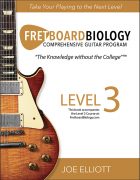LEVEL 3
Welcome to Level 3
Fretboard Biology Level 3 builds on the Levels 1 and 2 material. If you haven’t completed those levels, go back and at the very least make sure you are confident in all the material. In Level 3 you will continue the study of Theory, Fretboard Logic, Technique, Rhythm Guitar, Improvisation and practice techniques.
Theory
In the theory modules you will learn about recognizing and building 7th chords. Next you will learn to harmonize the major and natural minor scales with 7th chords. With your knowledge of the harmonized scales, you will learn harmonic analysis in progression with 7th chords. You will also learn about blues harmony and melody.
Fretboard Logic
In the fretboard logic modules you will learn major7, dominant7, minor7 and minor7(b5) arpeggios and how they fit into the “family tree” of the fretboard. The family tree keeps all the fretboard logic information organized. In addition, you will learn to organize arpeggios “in position,” so they are readily accessible to you in any key.
You will learn five patterns each of moveable major7, dominant7, minor7 and minor7(b5) chords and how they fit within the family tree.
Technique
In the technique modules you will learn a variety of chop building scale and interval sequences.
Rhythm Guitar
In the rhythm guitar modules you will study two styles: Reggae and Country.
There is a new sequence of modules called “Money Makers” in Level 3. This series focuses on must-know low-hanging-fruit guitar vocabulary.
As always there is continued guidance on building effective practice routines.
This is a progressive course. Each module in each level builds on the information from the previous one. You’ll get the most out of the program by staying with the sequence.
Improvisation
In the improvisation modules you will learn how to solo in various progressions that use 7th chords and as always, striving for good story telling through motif development and the use of the elements of contrast.
Let’s get started.


